Organisational Behaviour
VerifiedAdded on 2023/01/05
|18
|3385
|48
AI Summary
This report analyzes the impact of organisational culture, power, and politics on team and individual performance. It evaluates motivational theories and techniques for effective goal achievement. It explains the characteristics of effective teams and applies concepts of organisational behaviour in a given business situation. The subject is Organisational Behaviour, and the document type is a report.
Contribute Materials
Your contribution can guide someone’s learning journey. Share your
documents today.
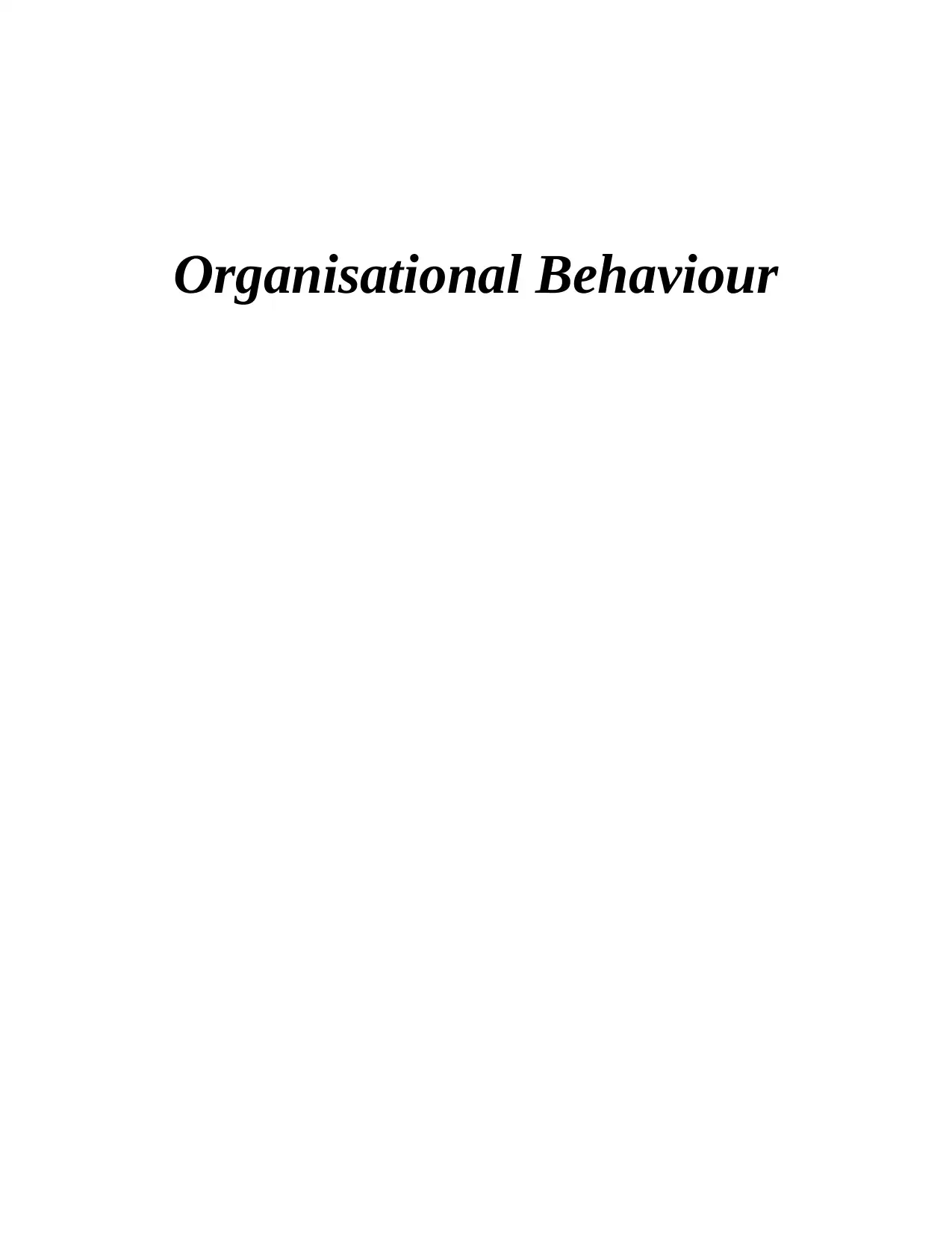
Organisational Behaviour
Secure Best Marks with AI Grader
Need help grading? Try our AI Grader for instant feedback on your assignments.
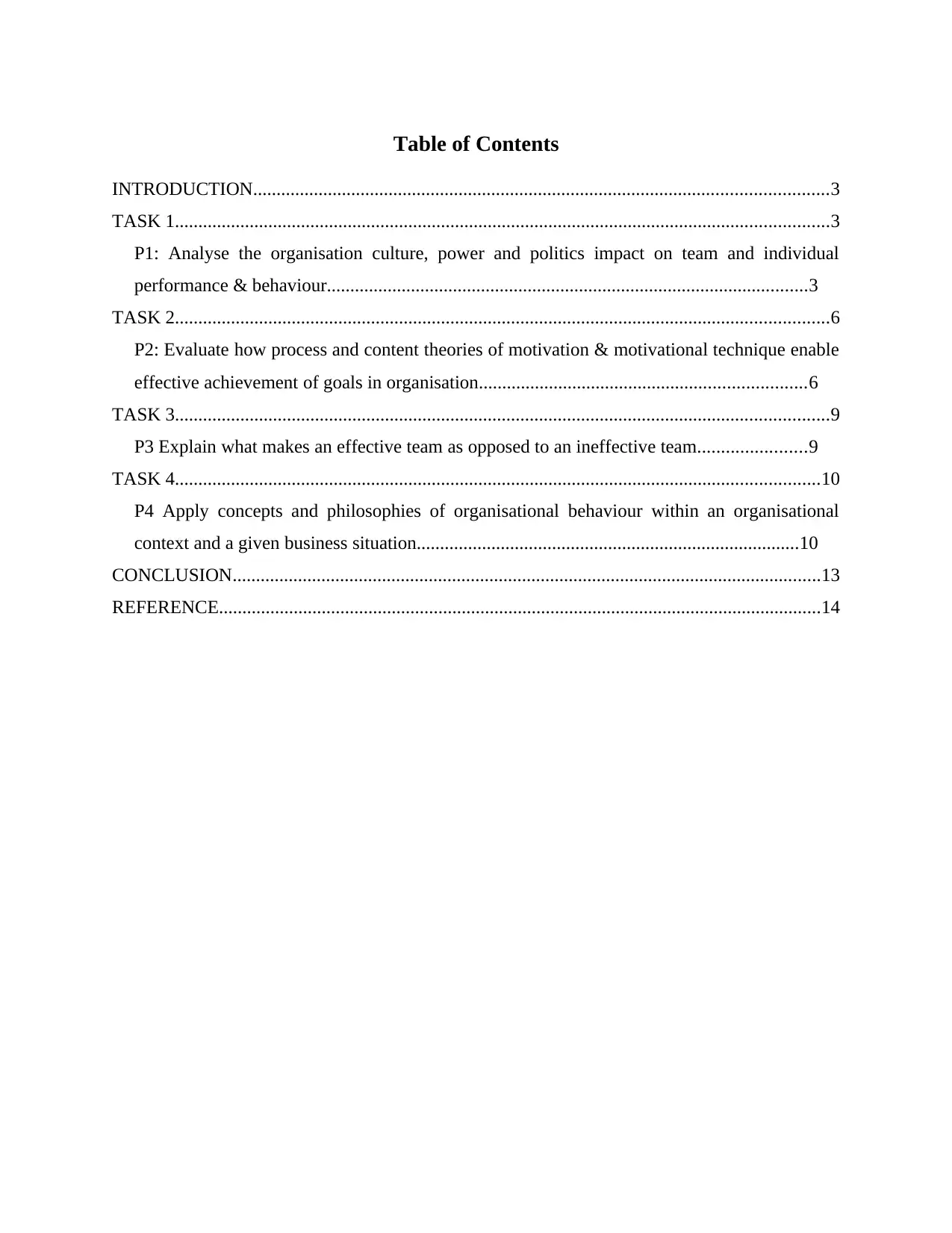
Table of Contents
INTRODUCTION...........................................................................................................................3
TASK 1............................................................................................................................................3
P1: Analyse the organisation culture, power and politics impact on team and individual
performance & behaviour.......................................................................................................3
TASK 2............................................................................................................................................6
P2: Evaluate how process and content theories of motivation & motivational technique enable
effective achievement of goals in organisation......................................................................6
TASK 3............................................................................................................................................9
P3 Explain what makes an effective team as opposed to an ineffective team.......................9
TASK 4..........................................................................................................................................10
P4 Apply concepts and philosophies of organisational behaviour within an organisational
context and a given business situation..................................................................................10
CONCLUSION..............................................................................................................................13
REFERENCE.................................................................................................................................14
INTRODUCTION...........................................................................................................................3
TASK 1............................................................................................................................................3
P1: Analyse the organisation culture, power and politics impact on team and individual
performance & behaviour.......................................................................................................3
TASK 2............................................................................................................................................6
P2: Evaluate how process and content theories of motivation & motivational technique enable
effective achievement of goals in organisation......................................................................6
TASK 3............................................................................................................................................9
P3 Explain what makes an effective team as opposed to an ineffective team.......................9
TASK 4..........................................................................................................................................10
P4 Apply concepts and philosophies of organisational behaviour within an organisational
context and a given business situation..................................................................................10
CONCLUSION..............................................................................................................................13
REFERENCE.................................................................................................................................14
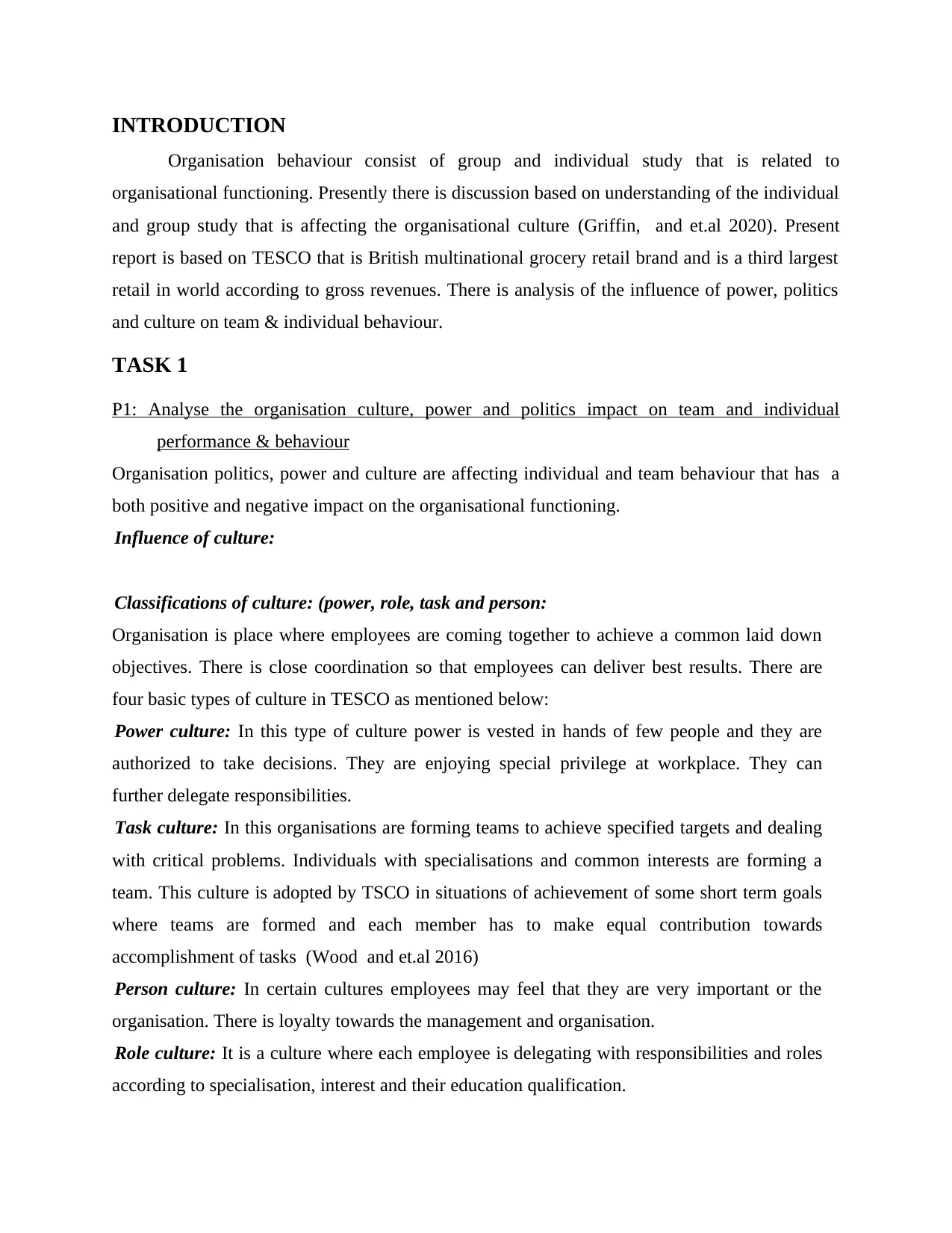
INTRODUCTION
Organisation behaviour consist of group and individual study that is related to
organisational functioning. Presently there is discussion based on understanding of the individual
and group study that is affecting the organisational culture (Griffin, and et.al 2020). Present
report is based on TESCO that is British multinational grocery retail brand and is a third largest
retail in world according to gross revenues. There is analysis of the influence of power, politics
and culture on team & individual behaviour.
TASK 1
P1: Analyse the organisation culture, power and politics impact on team and individual
performance & behaviour
Organisation politics, power and culture are affecting individual and team behaviour that has a
both positive and negative impact on the organisational functioning.
Influence of culture:
Classifications of culture: (power, role, task and person:
Organisation is place where employees are coming together to achieve a common laid down
objectives. There is close coordination so that employees can deliver best results. There are
four basic types of culture in TESCO as mentioned below:
Power culture: In this type of culture power is vested in hands of few people and they are
authorized to take decisions. They are enjoying special privilege at workplace. They can
further delegate responsibilities.
Task culture: In this organisations are forming teams to achieve specified targets and dealing
with critical problems. Individuals with specialisations and common interests are forming a
team. This culture is adopted by TSCO in situations of achievement of some short term goals
where teams are formed and each member has to make equal contribution towards
accomplishment of tasks (Wood and et.al 2016)
Person culture: In certain cultures employees may feel that they are very important or the
organisation. There is loyalty towards the management and organisation.
Role culture: It is a culture where each employee is delegating with responsibilities and roles
according to specialisation, interest and their education qualification.
Organisation behaviour consist of group and individual study that is related to
organisational functioning. Presently there is discussion based on understanding of the individual
and group study that is affecting the organisational culture (Griffin, and et.al 2020). Present
report is based on TESCO that is British multinational grocery retail brand and is a third largest
retail in world according to gross revenues. There is analysis of the influence of power, politics
and culture on team & individual behaviour.
TASK 1
P1: Analyse the organisation culture, power and politics impact on team and individual
performance & behaviour
Organisation politics, power and culture are affecting individual and team behaviour that has a
both positive and negative impact on the organisational functioning.
Influence of culture:
Classifications of culture: (power, role, task and person:
Organisation is place where employees are coming together to achieve a common laid down
objectives. There is close coordination so that employees can deliver best results. There are
four basic types of culture in TESCO as mentioned below:
Power culture: In this type of culture power is vested in hands of few people and they are
authorized to take decisions. They are enjoying special privilege at workplace. They can
further delegate responsibilities.
Task culture: In this organisations are forming teams to achieve specified targets and dealing
with critical problems. Individuals with specialisations and common interests are forming a
team. This culture is adopted by TSCO in situations of achievement of some short term goals
where teams are formed and each member has to make equal contribution towards
accomplishment of tasks (Wood and et.al 2016)
Person culture: In certain cultures employees may feel that they are very important or the
organisation. There is loyalty towards the management and organisation.
Role culture: It is a culture where each employee is delegating with responsibilities and roles
according to specialisation, interest and their education qualification.
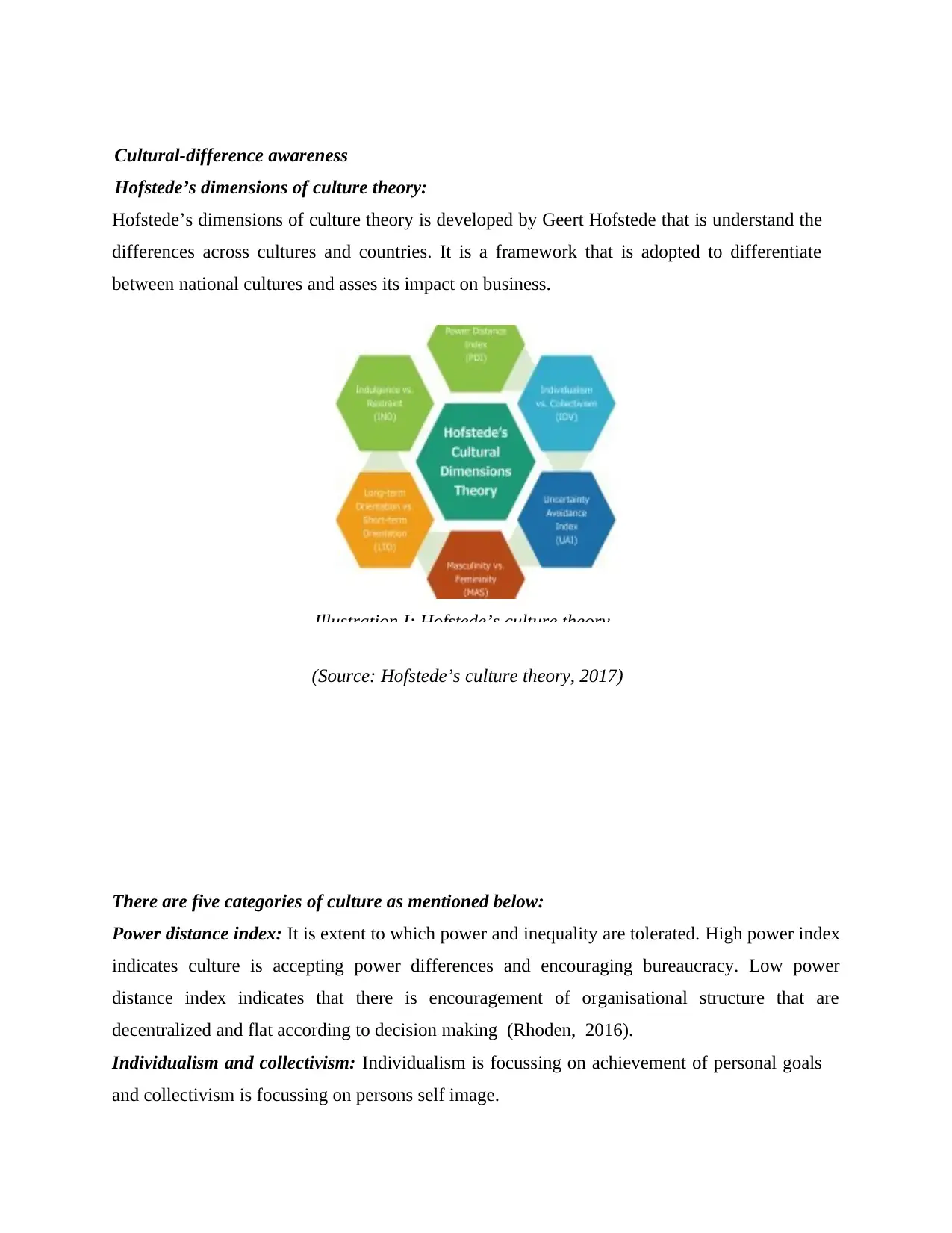
Cultural-difference awareness
Hofstede’s dimensions of culture theory:
Hofstede’s dimensions of culture theory is developed by Geert Hofstede that is understand the
differences across cultures and countries. It is a framework that is adopted to differentiate
between national cultures and asses its impact on business.
(Source: Hofstede’s culture theory, 2017)
There are five categories of culture as mentioned below:
Power distance index: It is extent to which power and inequality are tolerated. High power index
indicates culture is accepting power differences and encouraging bureaucracy. Low power
distance index indicates that there is encouragement of organisational structure that are
decentralized and flat according to decision making (Rhoden, 2016).
Individualism and collectivism: Individualism is focussing on achievement of personal goals
and collectivism is focussing on persons self image.
Illustration I: Hofstede’s culture theory
Hofstede’s dimensions of culture theory:
Hofstede’s dimensions of culture theory is developed by Geert Hofstede that is understand the
differences across cultures and countries. It is a framework that is adopted to differentiate
between national cultures and asses its impact on business.
(Source: Hofstede’s culture theory, 2017)
There are five categories of culture as mentioned below:
Power distance index: It is extent to which power and inequality are tolerated. High power index
indicates culture is accepting power differences and encouraging bureaucracy. Low power
distance index indicates that there is encouragement of organisational structure that are
decentralized and flat according to decision making (Rhoden, 2016).
Individualism and collectivism: Individualism is focussing on achievement of personal goals
and collectivism is focussing on persons self image.
Illustration I: Hofstede’s culture theory
Secure Best Marks with AI Grader
Need help grading? Try our AI Grader for instant feedback on your assignments.
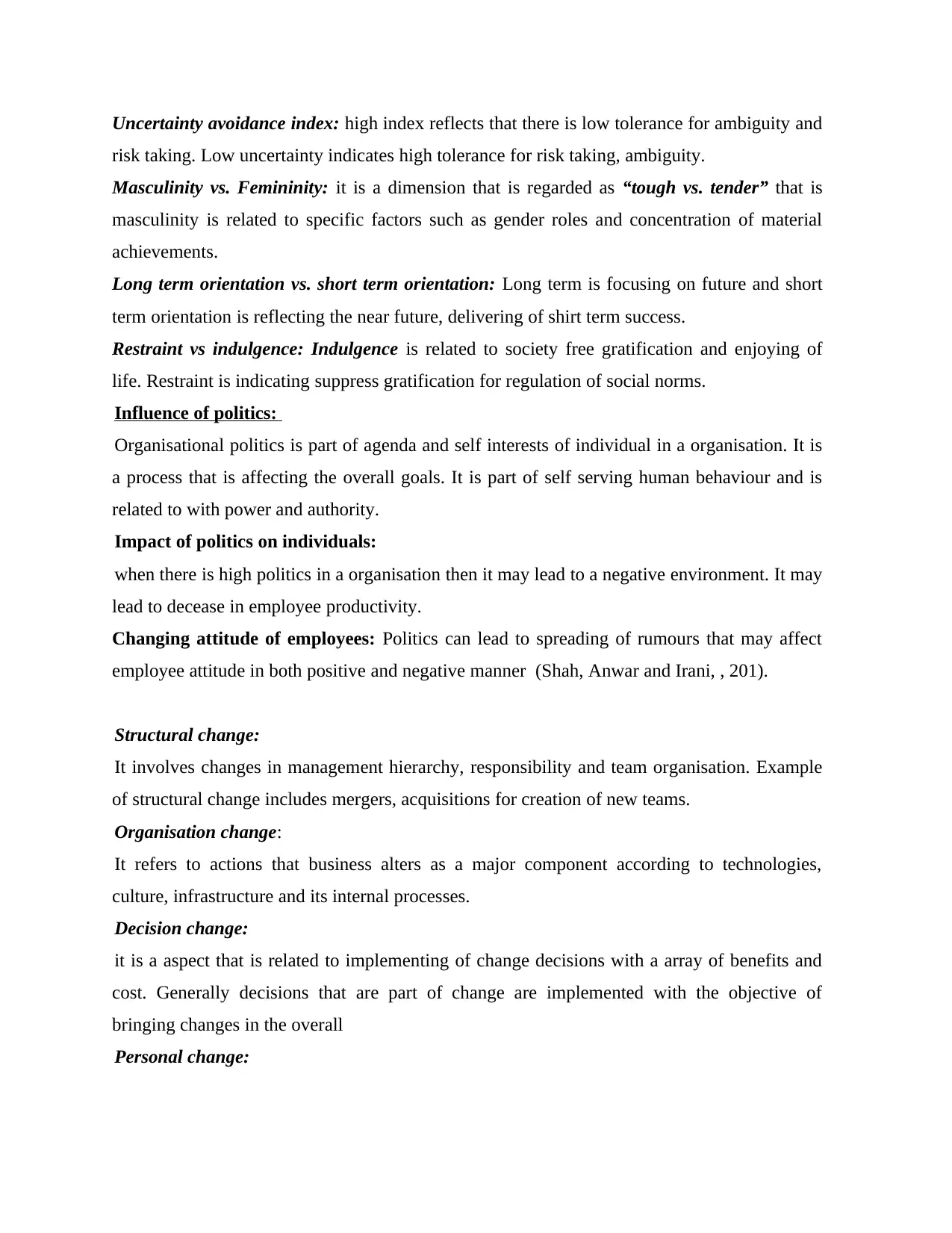
Uncertainty avoidance index: high index reflects that there is low tolerance for ambiguity and
risk taking. Low uncertainty indicates high tolerance for risk taking, ambiguity.
Masculinity vs. Femininity: it is a dimension that is regarded as “tough vs. tender” that is
masculinity is related to specific factors such as gender roles and concentration of material
achievements.
Long term orientation vs. short term orientation: Long term is focusing on future and short
term orientation is reflecting the near future, delivering of shirt term success.
Restraint vs indulgence: Indulgence is related to society free gratification and enjoying of
life. Restraint is indicating suppress gratification for regulation of social norms.
Influence of politics:
Organisational politics is part of agenda and self interests of individual in a organisation. It is
a process that is affecting the overall goals. It is part of self serving human behaviour and is
related to with power and authority.
Impact of politics on individuals:
when there is high politics in a organisation then it may lead to a negative environment. It may
lead to decease in employee productivity.
Changing attitude of employees: Politics can lead to spreading of rumours that may affect
employee attitude in both positive and negative manner (Shah, Anwar and Irani, , 201).
Structural change:
It involves changes in management hierarchy, responsibility and team organisation. Example
of structural change includes mergers, acquisitions for creation of new teams.
Organisation change:
It refers to actions that business alters as a major component according to technologies,
culture, infrastructure and its internal processes.
Decision change:
it is a aspect that is related to implementing of change decisions with a array of benefits and
cost. Generally decisions that are part of change are implemented with the objective of
bringing changes in the overall
Personal change:
risk taking. Low uncertainty indicates high tolerance for risk taking, ambiguity.
Masculinity vs. Femininity: it is a dimension that is regarded as “tough vs. tender” that is
masculinity is related to specific factors such as gender roles and concentration of material
achievements.
Long term orientation vs. short term orientation: Long term is focusing on future and short
term orientation is reflecting the near future, delivering of shirt term success.
Restraint vs indulgence: Indulgence is related to society free gratification and enjoying of
life. Restraint is indicating suppress gratification for regulation of social norms.
Influence of politics:
Organisational politics is part of agenda and self interests of individual in a organisation. It is
a process that is affecting the overall goals. It is part of self serving human behaviour and is
related to with power and authority.
Impact of politics on individuals:
when there is high politics in a organisation then it may lead to a negative environment. It may
lead to decease in employee productivity.
Changing attitude of employees: Politics can lead to spreading of rumours that may affect
employee attitude in both positive and negative manner (Shah, Anwar and Irani, , 201).
Structural change:
It involves changes in management hierarchy, responsibility and team organisation. Example
of structural change includes mergers, acquisitions for creation of new teams.
Organisation change:
It refers to actions that business alters as a major component according to technologies,
culture, infrastructure and its internal processes.
Decision change:
it is a aspect that is related to implementing of change decisions with a array of benefits and
cost. Generally decisions that are part of change are implemented with the objective of
bringing changes in the overall
Personal change:
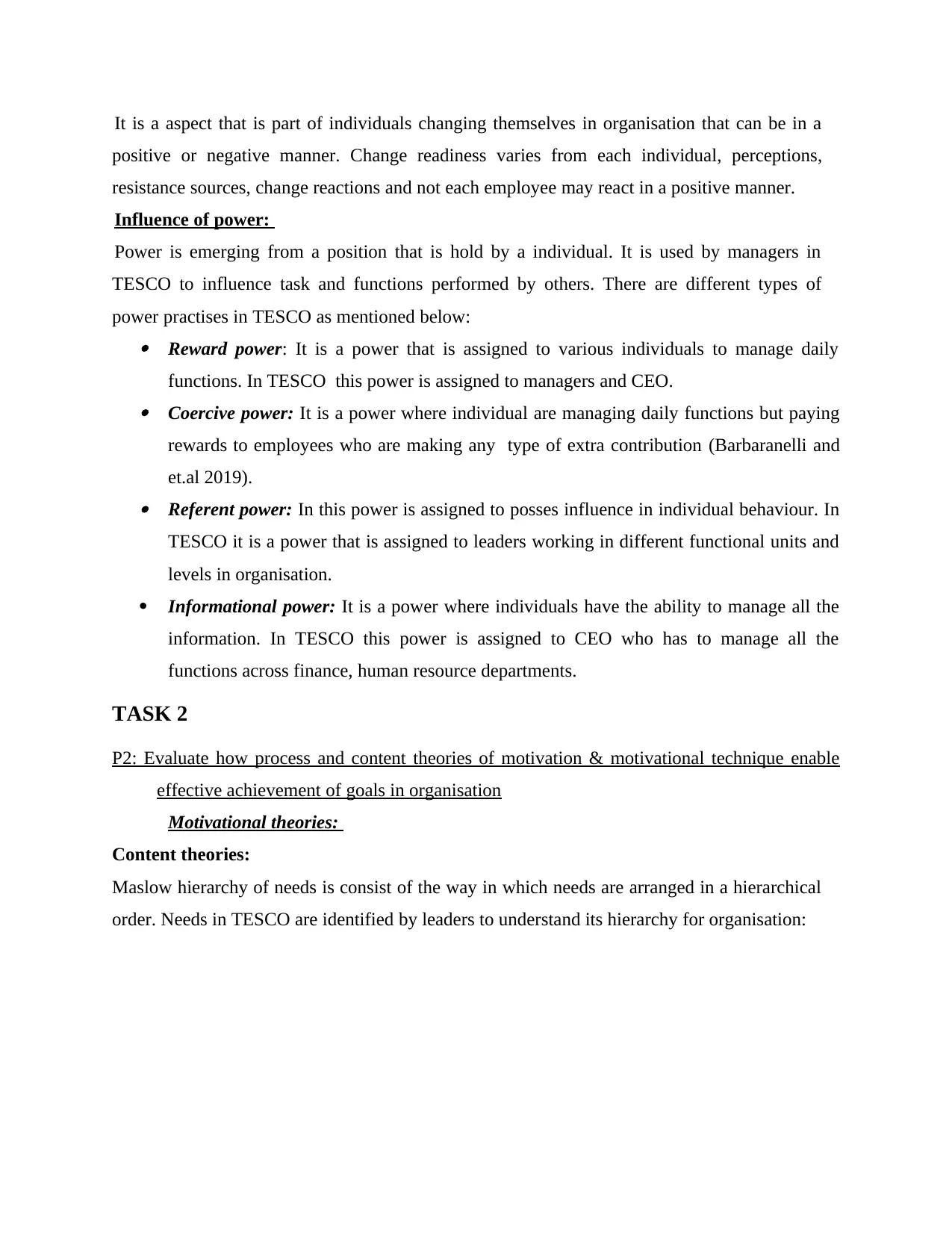
It is a aspect that is part of individuals changing themselves in organisation that can be in a
positive or negative manner. Change readiness varies from each individual, perceptions,
resistance sources, change reactions and not each employee may react in a positive manner.
Influence of power:
Power is emerging from a position that is hold by a individual. It is used by managers in
TESCO to influence task and functions performed by others. There are different types of
power practises in TESCO as mentioned below: Reward power: It is a power that is assigned to various individuals to manage daily
functions. In TESCO this power is assigned to managers and CEO. Coercive power: It is a power where individual are managing daily functions but paying
rewards to employees who are making any type of extra contribution (Barbaranelli and
et.al 2019). Referent power: In this power is assigned to posses influence in individual behaviour. In
TESCO it is a power that is assigned to leaders working in different functional units and
levels in organisation.
Informational power: It is a power where individuals have the ability to manage all the
information. In TESCO this power is assigned to CEO who has to manage all the
functions across finance, human resource departments.
TASK 2
P2: Evaluate how process and content theories of motivation & motivational technique enable
effective achievement of goals in organisation
Motivational theories:
Content theories:
Maslow hierarchy of needs is consist of the way in which needs are arranged in a hierarchical
order. Needs in TESCO are identified by leaders to understand its hierarchy for organisation:
positive or negative manner. Change readiness varies from each individual, perceptions,
resistance sources, change reactions and not each employee may react in a positive manner.
Influence of power:
Power is emerging from a position that is hold by a individual. It is used by managers in
TESCO to influence task and functions performed by others. There are different types of
power practises in TESCO as mentioned below: Reward power: It is a power that is assigned to various individuals to manage daily
functions. In TESCO this power is assigned to managers and CEO. Coercive power: It is a power where individual are managing daily functions but paying
rewards to employees who are making any type of extra contribution (Barbaranelli and
et.al 2019). Referent power: In this power is assigned to posses influence in individual behaviour. In
TESCO it is a power that is assigned to leaders working in different functional units and
levels in organisation.
Informational power: It is a power where individuals have the ability to manage all the
information. In TESCO this power is assigned to CEO who has to manage all the
functions across finance, human resource departments.
TASK 2
P2: Evaluate how process and content theories of motivation & motivational technique enable
effective achievement of goals in organisation
Motivational theories:
Content theories:
Maslow hierarchy of needs is consist of the way in which needs are arranged in a hierarchical
order. Needs in TESCO are identified by leaders to understand its hierarchy for organisation:
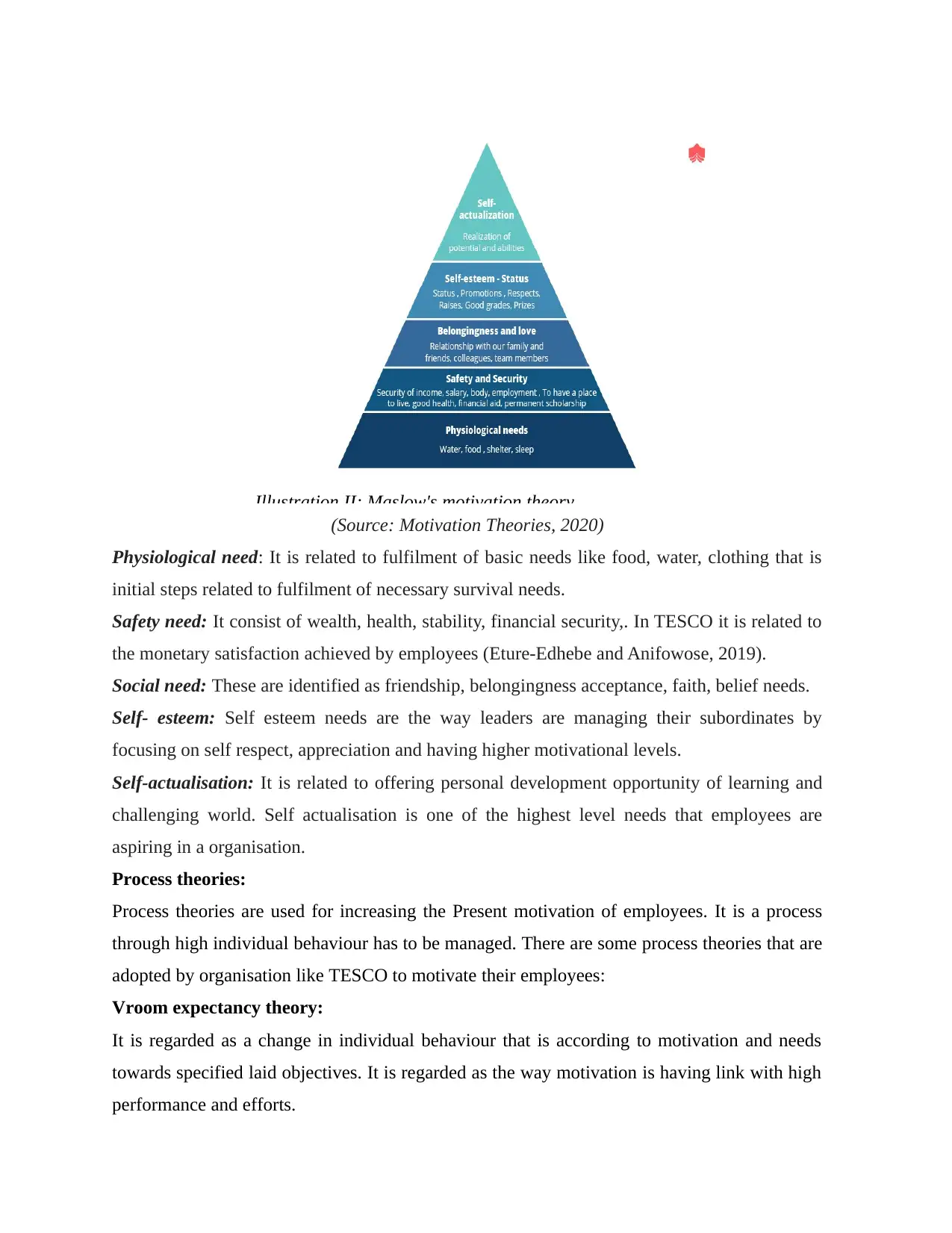
(Source: Motivation Theories, 2020)
Physiological need: It is related to fulfilment of basic needs like food, water, clothing that is
initial steps related to fulfilment of necessary survival needs.
Safety need: It consist of wealth, health, stability, financial security,. In TESCO it is related to
the monetary satisfaction achieved by employees (Eture-Edhebe and Anifowose, 2019).
Social need: These are identified as friendship, belongingness acceptance, faith, belief needs.
Self- esteem: Self esteem needs are the way leaders are managing their subordinates by
focusing on self respect, appreciation and having higher motivational levels.
Self-actualisation: It is related to offering personal development opportunity of learning and
challenging world. Self actualisation is one of the highest level needs that employees are
aspiring in a organisation.
Process theories:
Process theories are used for increasing the Present motivation of employees. It is a process
through high individual behaviour has to be managed. There are some process theories that are
adopted by organisation like TESCO to motivate their employees:
Vroom expectancy theory:
It is regarded as a change in individual behaviour that is according to motivation and needs
towards specified laid objectives. It is regarded as the way motivation is having link with high
performance and efforts.
Illustration II: Maslow's motivation theory
Physiological need: It is related to fulfilment of basic needs like food, water, clothing that is
initial steps related to fulfilment of necessary survival needs.
Safety need: It consist of wealth, health, stability, financial security,. In TESCO it is related to
the monetary satisfaction achieved by employees (Eture-Edhebe and Anifowose, 2019).
Social need: These are identified as friendship, belongingness acceptance, faith, belief needs.
Self- esteem: Self esteem needs are the way leaders are managing their subordinates by
focusing on self respect, appreciation and having higher motivational levels.
Self-actualisation: It is related to offering personal development opportunity of learning and
challenging world. Self actualisation is one of the highest level needs that employees are
aspiring in a organisation.
Process theories:
Process theories are used for increasing the Present motivation of employees. It is a process
through high individual behaviour has to be managed. There are some process theories that are
adopted by organisation like TESCO to motivate their employees:
Vroom expectancy theory:
It is regarded as a change in individual behaviour that is according to motivation and needs
towards specified laid objectives. It is regarded as the way motivation is having link with high
performance and efforts.
Illustration II: Maslow's motivation theory
Paraphrase This Document
Need a fresh take? Get an instant paraphrase of this document with our AI Paraphraser
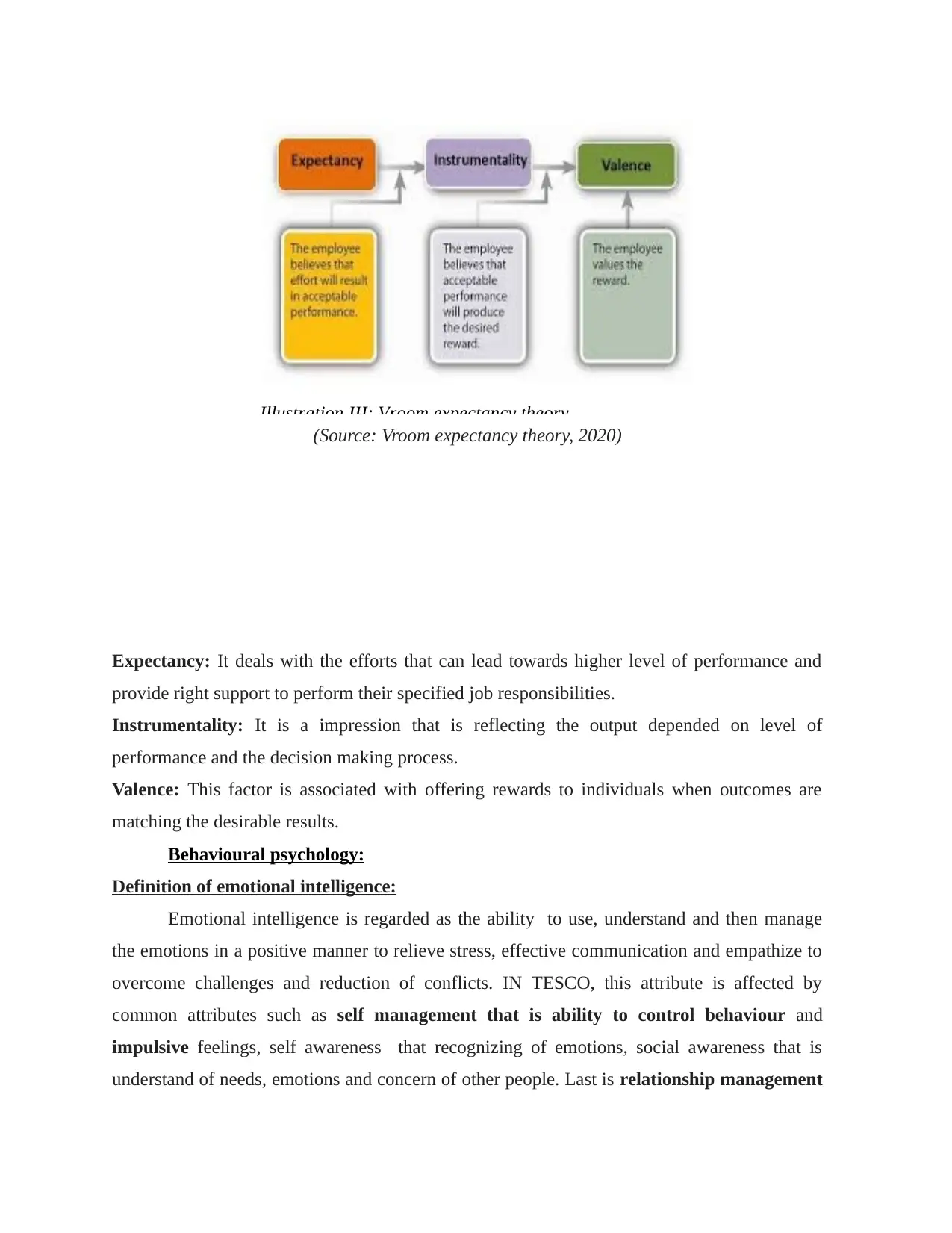
(Source: Vroom expectancy theory, 2020)
Expectancy: It deals with the efforts that can lead towards higher level of performance and
provide right support to perform their specified job responsibilities.
Instrumentality: It is a impression that is reflecting the output depended on level of
performance and the decision making process.
Valence: This factor is associated with offering rewards to individuals when outcomes are
matching the desirable results.
Behavioural psychology:
Definition of emotional intelligence:
Emotional intelligence is regarded as the ability to use, understand and then manage
the emotions in a positive manner to relieve stress, effective communication and empathize to
overcome challenges and reduction of conflicts. IN TESCO, this attribute is affected by
common attributes such as self management that is ability to control behaviour and
impulsive feelings, self awareness that recognizing of emotions, social awareness that is
understand of needs, emotions and concern of other people. Last is relationship management
Illustration III: Vroom expectancy theory
Expectancy: It deals with the efforts that can lead towards higher level of performance and
provide right support to perform their specified job responsibilities.
Instrumentality: It is a impression that is reflecting the output depended on level of
performance and the decision making process.
Valence: This factor is associated with offering rewards to individuals when outcomes are
matching the desirable results.
Behavioural psychology:
Definition of emotional intelligence:
Emotional intelligence is regarded as the ability to use, understand and then manage
the emotions in a positive manner to relieve stress, effective communication and empathize to
overcome challenges and reduction of conflicts. IN TESCO, this attribute is affected by
common attributes such as self management that is ability to control behaviour and
impulsive feelings, self awareness that recognizing of emotions, social awareness that is
understand of needs, emotions and concern of other people. Last is relationship management
Illustration III: Vroom expectancy theory
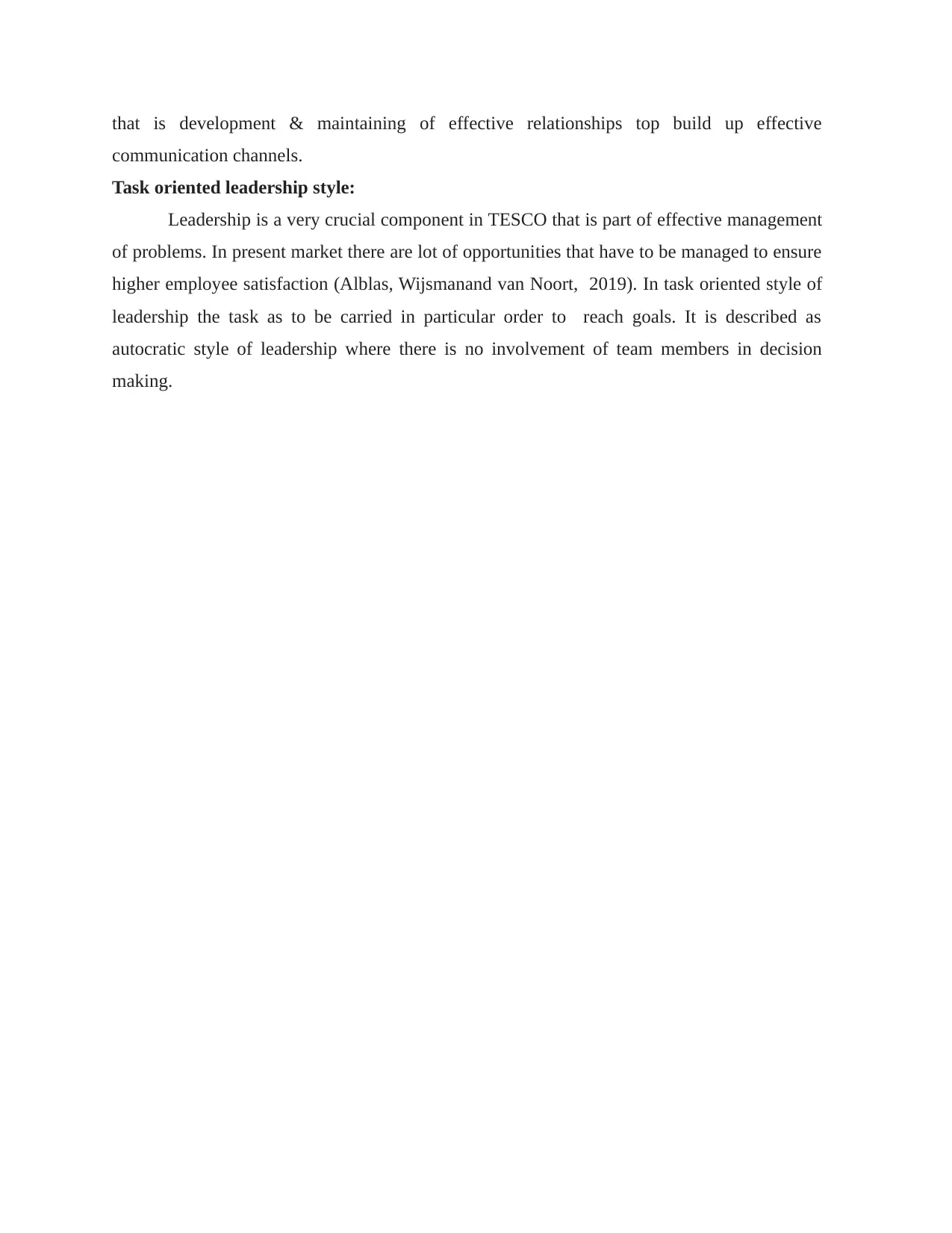
that is development & maintaining of effective relationships top build up effective
communication channels.
Task oriented leadership style:
Leadership is a very crucial component in TESCO that is part of effective management
of problems. In present market there are lot of opportunities that have to be managed to ensure
higher employee satisfaction (Alblas, Wijsmanand van Noort, 2019). In task oriented style of
leadership the task as to be carried in particular order to reach goals. It is described as
autocratic style of leadership where there is no involvement of team members in decision
making.
communication channels.
Task oriented leadership style:
Leadership is a very crucial component in TESCO that is part of effective management
of problems. In present market there are lot of opportunities that have to be managed to ensure
higher employee satisfaction (Alblas, Wijsmanand van Noort, 2019). In task oriented style of
leadership the task as to be carried in particular order to reach goals. It is described as
autocratic style of leadership where there is no involvement of team members in decision
making.
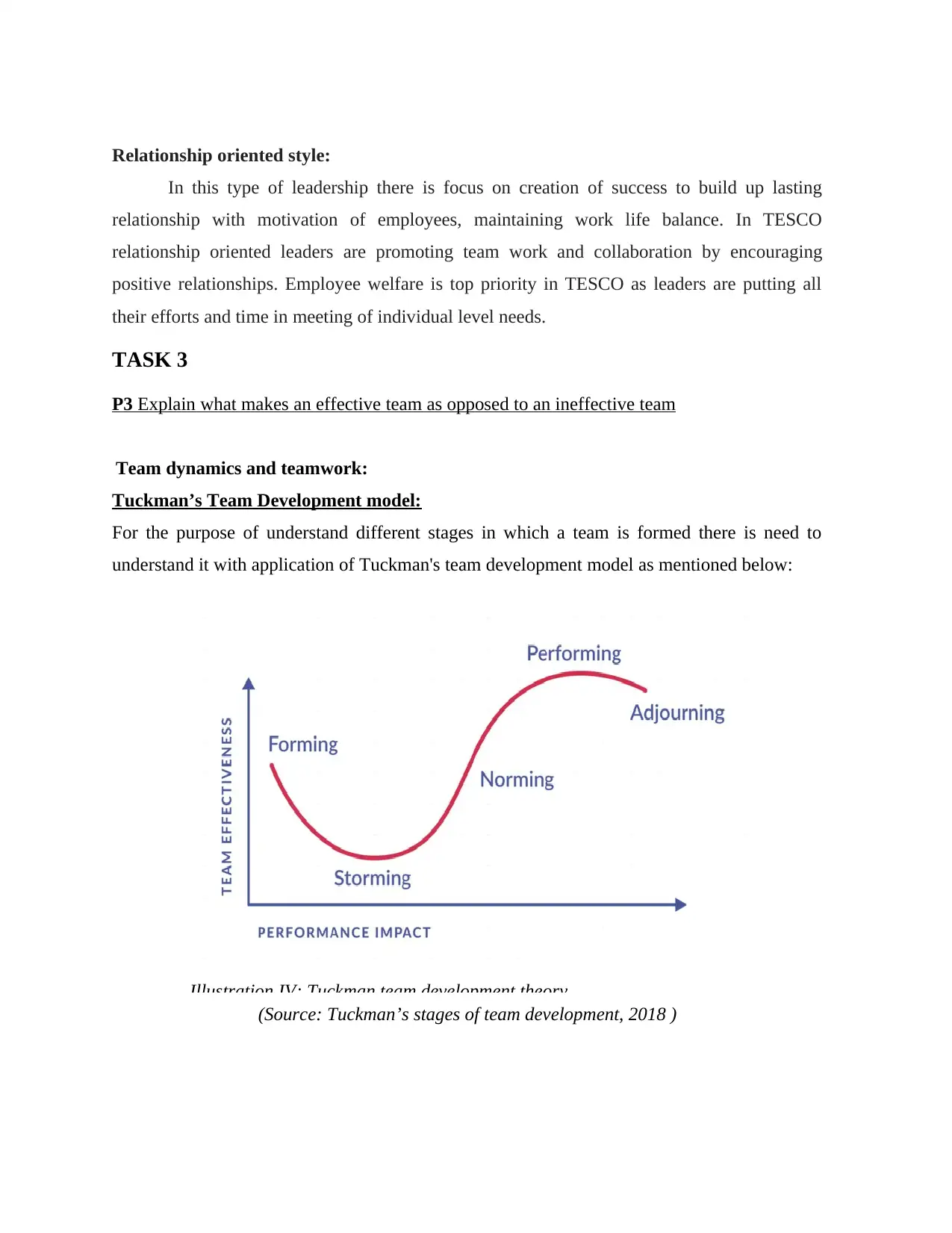
Relationship oriented style:
In this type of leadership there is focus on creation of success to build up lasting
relationship with motivation of employees, maintaining work life balance. In TESCO
relationship oriented leaders are promoting team work and collaboration by encouraging
positive relationships. Employee welfare is top priority in TESCO as leaders are putting all
their efforts and time in meeting of individual level needs.
TASK 3
P3 Explain what makes an effective team as opposed to an ineffective team
Team dynamics and teamwork:
Tuckman’s Team Development model:
For the purpose of understand different stages in which a team is formed there is need to
understand it with application of Tuckman's team development model as mentioned below:
(Source: Tuckman’s stages of team development, 2018 )
Illustration IV: Tuckman team development theory
In this type of leadership there is focus on creation of success to build up lasting
relationship with motivation of employees, maintaining work life balance. In TESCO
relationship oriented leaders are promoting team work and collaboration by encouraging
positive relationships. Employee welfare is top priority in TESCO as leaders are putting all
their efforts and time in meeting of individual level needs.
TASK 3
P3 Explain what makes an effective team as opposed to an ineffective team
Team dynamics and teamwork:
Tuckman’s Team Development model:
For the purpose of understand different stages in which a team is formed there is need to
understand it with application of Tuckman's team development model as mentioned below:
(Source: Tuckman’s stages of team development, 2018 )
Illustration IV: Tuckman team development theory
Secure Best Marks with AI Grader
Need help grading? Try our AI Grader for instant feedback on your assignments.
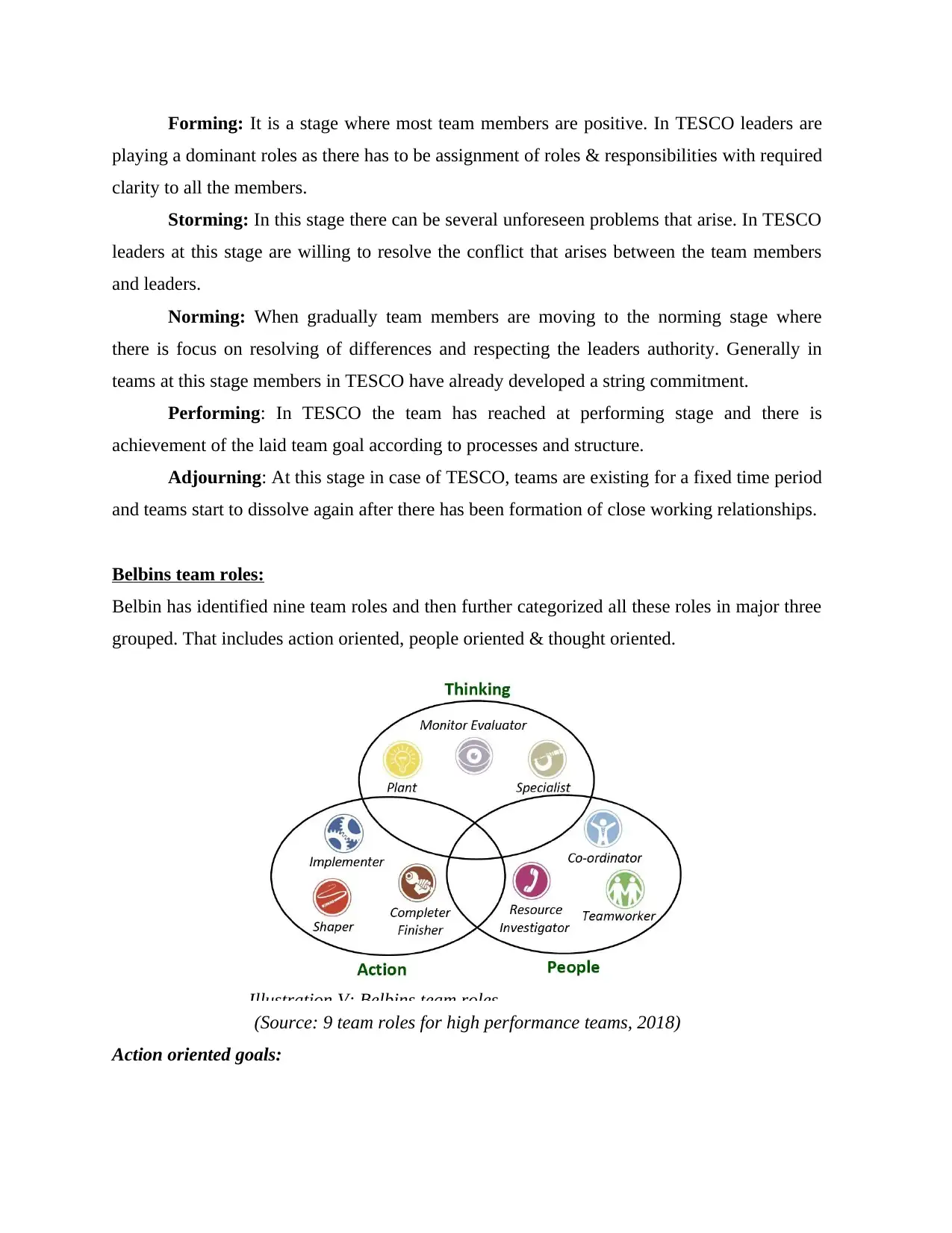
Forming: It is a stage where most team members are positive. In TESCO leaders are
playing a dominant roles as there has to be assignment of roles & responsibilities with required
clarity to all the members.
Storming: In this stage there can be several unforeseen problems that arise. In TESCO
leaders at this stage are willing to resolve the conflict that arises between the team members
and leaders.
Norming: When gradually team members are moving to the norming stage where
there is focus on resolving of differences and respecting the leaders authority. Generally in
teams at this stage members in TESCO have already developed a string commitment.
Performing: In TESCO the team has reached at performing stage and there is
achievement of the laid team goal according to processes and structure.
Adjourning: At this stage in case of TESCO, teams are existing for a fixed time period
and teams start to dissolve again after there has been formation of close working relationships.
Belbins team roles:
Belbin has identified nine team roles and then further categorized all these roles in major three
grouped. That includes action oriented, people oriented & thought oriented.
(Source: 9 team roles for high performance teams, 2018)
Action oriented goals:
Illustration V: Belbins team roles
playing a dominant roles as there has to be assignment of roles & responsibilities with required
clarity to all the members.
Storming: In this stage there can be several unforeseen problems that arise. In TESCO
leaders at this stage are willing to resolve the conflict that arises between the team members
and leaders.
Norming: When gradually team members are moving to the norming stage where
there is focus on resolving of differences and respecting the leaders authority. Generally in
teams at this stage members in TESCO have already developed a string commitment.
Performing: In TESCO the team has reached at performing stage and there is
achievement of the laid team goal according to processes and structure.
Adjourning: At this stage in case of TESCO, teams are existing for a fixed time period
and teams start to dissolve again after there has been formation of close working relationships.
Belbins team roles:
Belbin has identified nine team roles and then further categorized all these roles in major three
grouped. That includes action oriented, people oriented & thought oriented.
(Source: 9 team roles for high performance teams, 2018)
Action oriented goals:
Illustration V: Belbins team roles
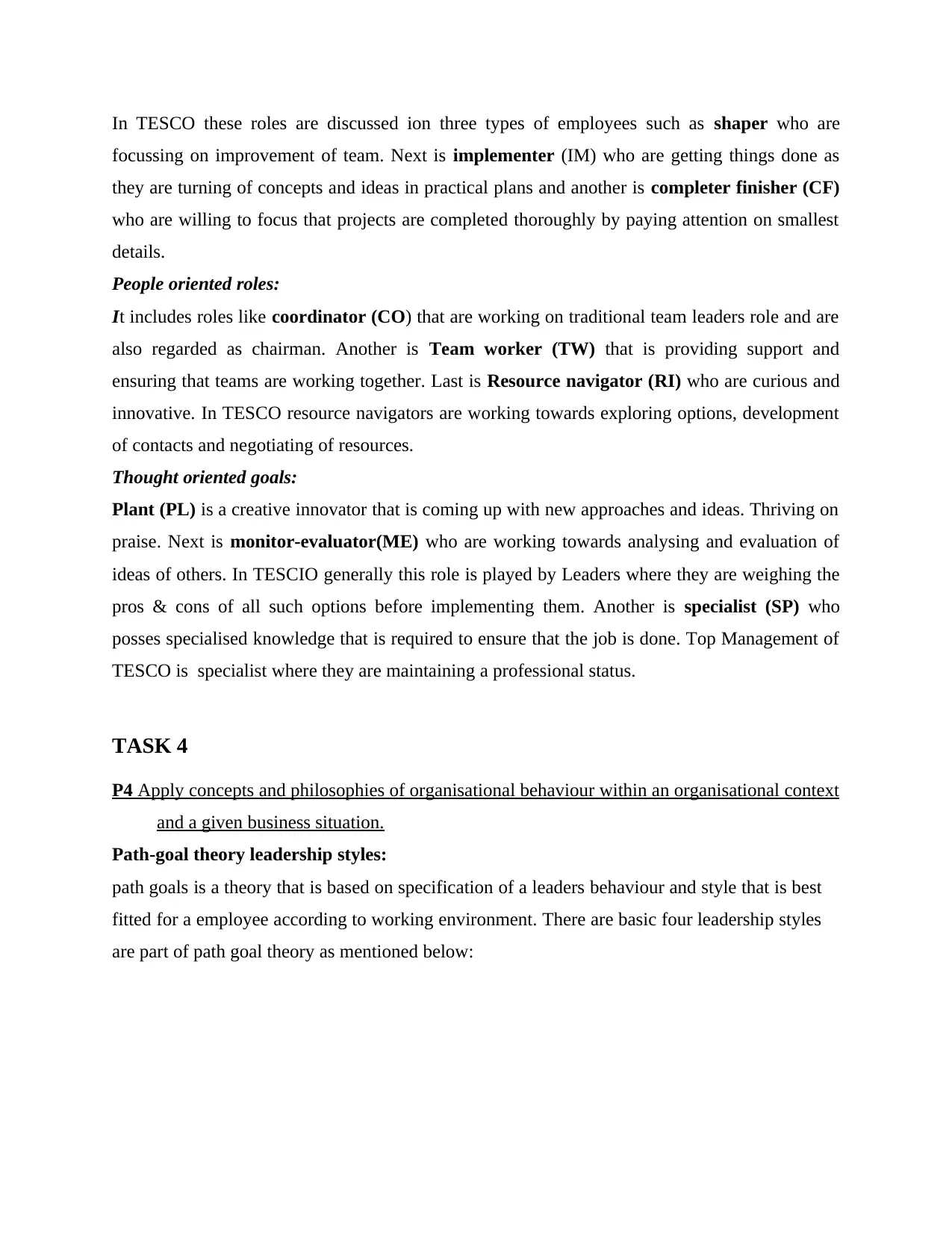
In TESCO these roles are discussed ion three types of employees such as shaper who are
focussing on improvement of team. Next is implementer (IM) who are getting things done as
they are turning of concepts and ideas in practical plans and another is completer finisher (CF)
who are willing to focus that projects are completed thoroughly by paying attention on smallest
details.
People oriented roles:
It includes roles like coordinator (CO) that are working on traditional team leaders role and are
also regarded as chairman. Another is Team worker (TW) that is providing support and
ensuring that teams are working together. Last is Resource navigator (RI) who are curious and
innovative. In TESCO resource navigators are working towards exploring options, development
of contacts and negotiating of resources.
Thought oriented goals:
Plant (PL) is a creative innovator that is coming up with new approaches and ideas. Thriving on
praise. Next is monitor-evaluator(ME) who are working towards analysing and evaluation of
ideas of others. In TESCIO generally this role is played by Leaders where they are weighing the
pros & cons of all such options before implementing them. Another is specialist (SP) who
posses specialised knowledge that is required to ensure that the job is done. Top Management of
TESCO is specialist where they are maintaining a professional status.
TASK 4
P4 Apply concepts and philosophies of organisational behaviour within an organisational context
and a given business situation.
Path-goal theory leadership styles:
path goals is a theory that is based on specification of a leaders behaviour and style that is best
fitted for a employee according to working environment. There are basic four leadership styles
are part of path goal theory as mentioned below:
focussing on improvement of team. Next is implementer (IM) who are getting things done as
they are turning of concepts and ideas in practical plans and another is completer finisher (CF)
who are willing to focus that projects are completed thoroughly by paying attention on smallest
details.
People oriented roles:
It includes roles like coordinator (CO) that are working on traditional team leaders role and are
also regarded as chairman. Another is Team worker (TW) that is providing support and
ensuring that teams are working together. Last is Resource navigator (RI) who are curious and
innovative. In TESCO resource navigators are working towards exploring options, development
of contacts and negotiating of resources.
Thought oriented goals:
Plant (PL) is a creative innovator that is coming up with new approaches and ideas. Thriving on
praise. Next is monitor-evaluator(ME) who are working towards analysing and evaluation of
ideas of others. In TESCIO generally this role is played by Leaders where they are weighing the
pros & cons of all such options before implementing them. Another is specialist (SP) who
posses specialised knowledge that is required to ensure that the job is done. Top Management of
TESCO is specialist where they are maintaining a professional status.
TASK 4
P4 Apply concepts and philosophies of organisational behaviour within an organisational context
and a given business situation.
Path-goal theory leadership styles:
path goals is a theory that is based on specification of a leaders behaviour and style that is best
fitted for a employee according to working environment. There are basic four leadership styles
are part of path goal theory as mentioned below:
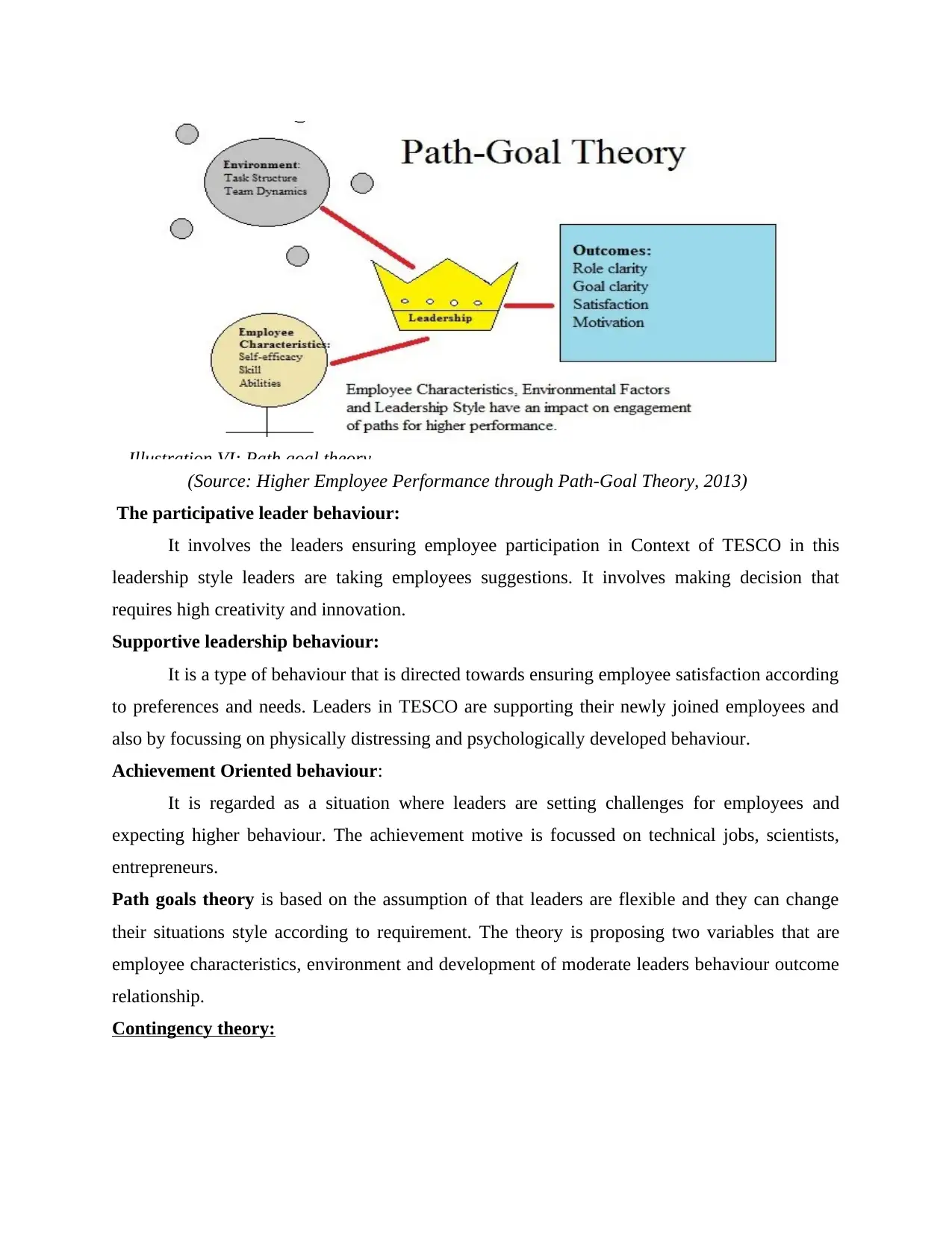
(Source: Higher Employee Performance through Path-Goal Theory, 2013)
The participative leader behaviour:
It involves the leaders ensuring employee participation in Context of TESCO in this
leadership style leaders are taking employees suggestions. It involves making decision that
requires high creativity and innovation.
Supportive leadership behaviour:
It is a type of behaviour that is directed towards ensuring employee satisfaction according
to preferences and needs. Leaders in TESCO are supporting their newly joined employees and
also by focussing on physically distressing and psychologically developed behaviour.
Achievement Oriented behaviour:
It is regarded as a situation where leaders are setting challenges for employees and
expecting higher behaviour. The achievement motive is focussed on technical jobs, scientists,
entrepreneurs.
Path goals theory is based on the assumption of that leaders are flexible and they can change
their situations style according to requirement. The theory is proposing two variables that are
employee characteristics, environment and development of moderate leaders behaviour outcome
relationship.
Contingency theory:
Illustration VI: Path goal theory
The participative leader behaviour:
It involves the leaders ensuring employee participation in Context of TESCO in this
leadership style leaders are taking employees suggestions. It involves making decision that
requires high creativity and innovation.
Supportive leadership behaviour:
It is a type of behaviour that is directed towards ensuring employee satisfaction according
to preferences and needs. Leaders in TESCO are supporting their newly joined employees and
also by focussing on physically distressing and psychologically developed behaviour.
Achievement Oriented behaviour:
It is regarded as a situation where leaders are setting challenges for employees and
expecting higher behaviour. The achievement motive is focussed on technical jobs, scientists,
entrepreneurs.
Path goals theory is based on the assumption of that leaders are flexible and they can change
their situations style according to requirement. The theory is proposing two variables that are
employee characteristics, environment and development of moderate leaders behaviour outcome
relationship.
Contingency theory:
Illustration VI: Path goal theory
Paraphrase This Document
Need a fresh take? Get an instant paraphrase of this document with our AI Paraphraser
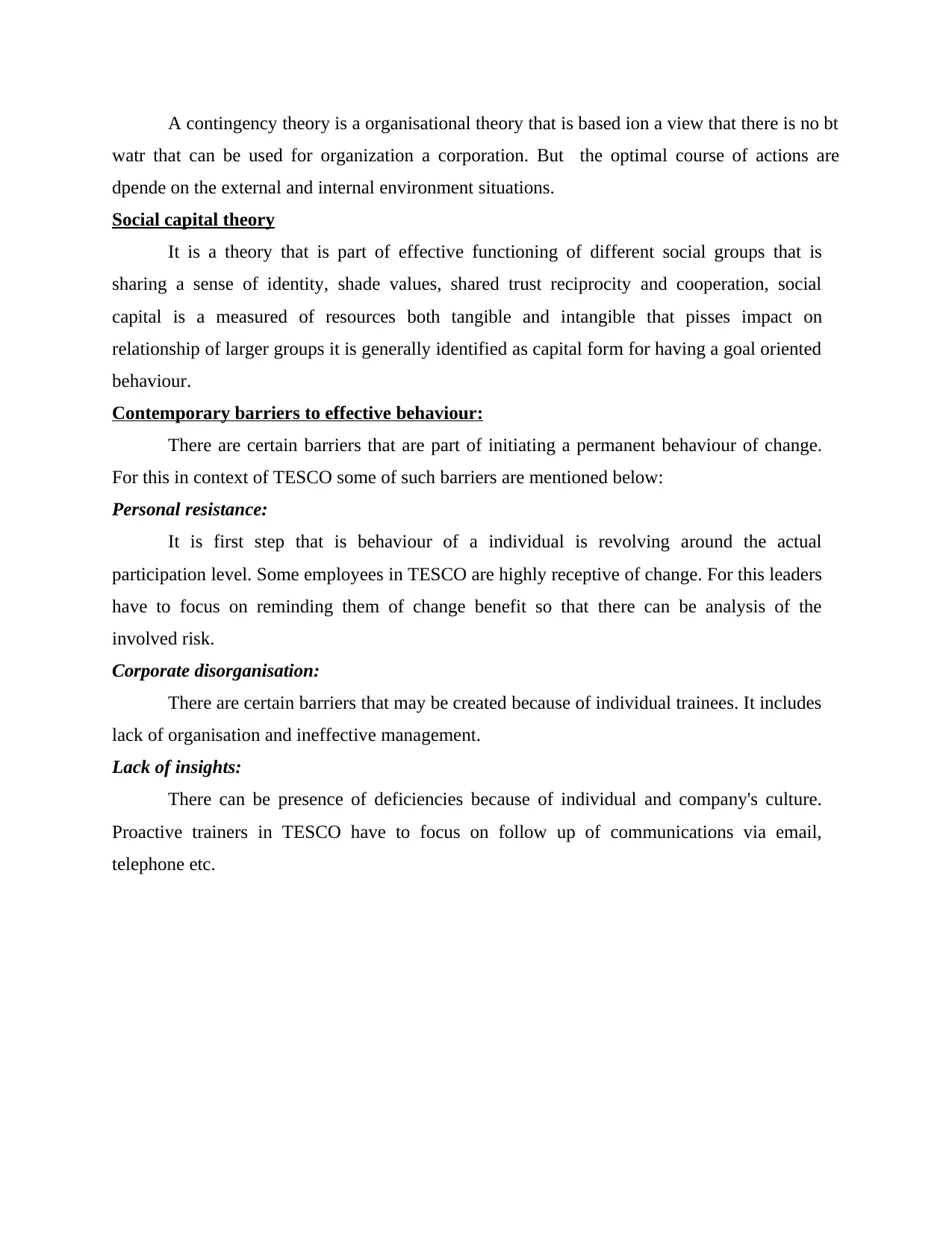
A contingency theory is a organisational theory that is based ion a view that there is no bt
watr that can be used for organization a corporation. But the optimal course of actions are
dpende on the external and internal environment situations.
Social capital theory
It is a theory that is part of effective functioning of different social groups that is
sharing a sense of identity, shade values, shared trust reciprocity and cooperation, social
capital is a measured of resources both tangible and intangible that pisses impact on
relationship of larger groups it is generally identified as capital form for having a goal oriented
behaviour.
Contemporary barriers to effective behaviour:
There are certain barriers that are part of initiating a permanent behaviour of change.
For this in context of TESCO some of such barriers are mentioned below:
Personal resistance:
It is first step that is behaviour of a individual is revolving around the actual
participation level. Some employees in TESCO are highly receptive of change. For this leaders
have to focus on reminding them of change benefit so that there can be analysis of the
involved risk.
Corporate disorganisation:
There are certain barriers that may be created because of individual trainees. It includes
lack of organisation and ineffective management.
Lack of insights:
There can be presence of deficiencies because of individual and company's culture.
Proactive trainers in TESCO have to focus on follow up of communications via email,
telephone etc.
watr that can be used for organization a corporation. But the optimal course of actions are
dpende on the external and internal environment situations.
Social capital theory
It is a theory that is part of effective functioning of different social groups that is
sharing a sense of identity, shade values, shared trust reciprocity and cooperation, social
capital is a measured of resources both tangible and intangible that pisses impact on
relationship of larger groups it is generally identified as capital form for having a goal oriented
behaviour.
Contemporary barriers to effective behaviour:
There are certain barriers that are part of initiating a permanent behaviour of change.
For this in context of TESCO some of such barriers are mentioned below:
Personal resistance:
It is first step that is behaviour of a individual is revolving around the actual
participation level. Some employees in TESCO are highly receptive of change. For this leaders
have to focus on reminding them of change benefit so that there can be analysis of the
involved risk.
Corporate disorganisation:
There are certain barriers that may be created because of individual trainees. It includes
lack of organisation and ineffective management.
Lack of insights:
There can be presence of deficiencies because of individual and company's culture.
Proactive trainers in TESCO have to focus on follow up of communications via email,
telephone etc.
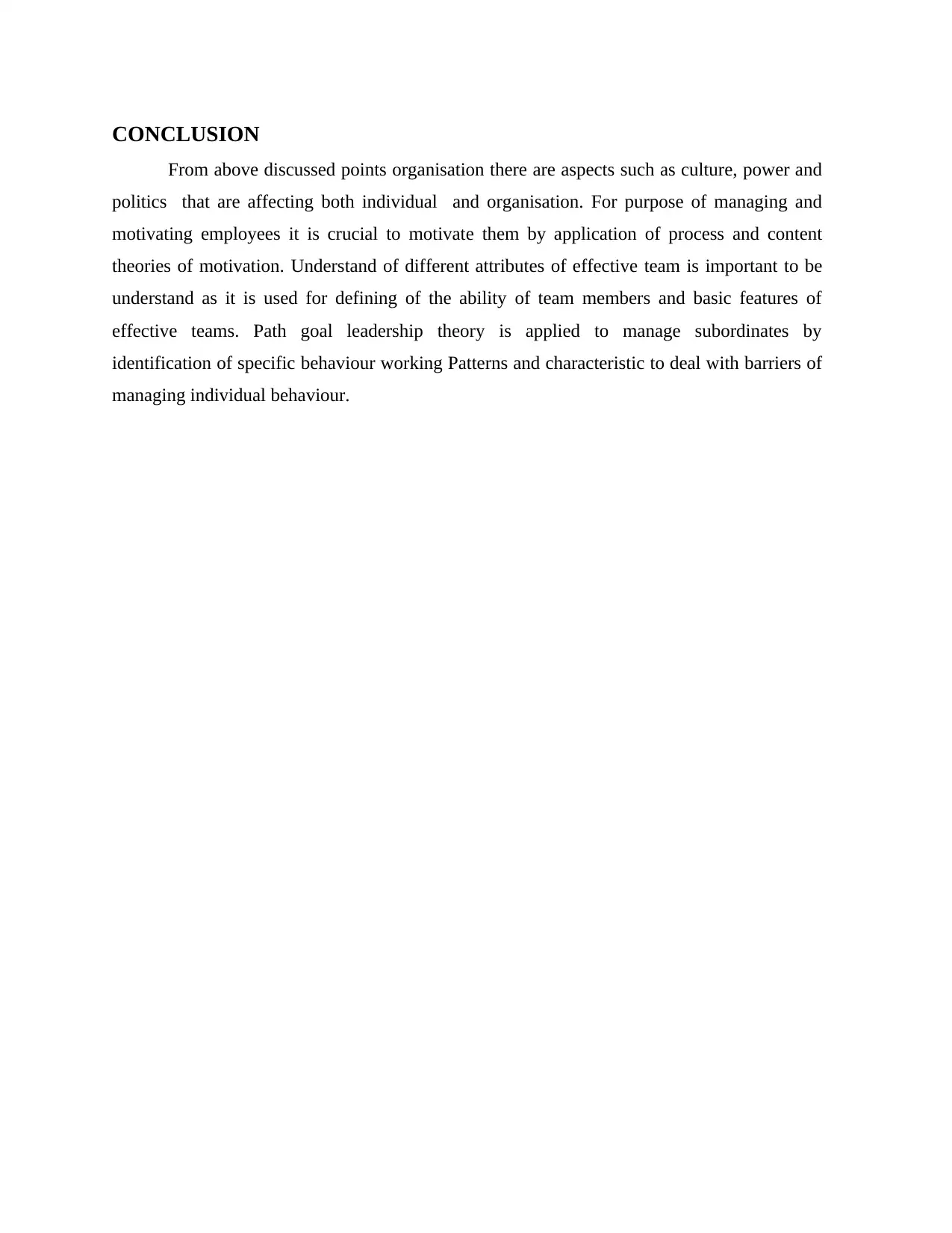
CONCLUSION
From above discussed points organisation there are aspects such as culture, power and
politics that are affecting both individual and organisation. For purpose of managing and
motivating employees it is crucial to motivate them by application of process and content
theories of motivation. Understand of different attributes of effective team is important to be
understand as it is used for defining of the ability of team members and basic features of
effective teams. Path goal leadership theory is applied to manage subordinates by
identification of specific behaviour working Patterns and characteristic to deal with barriers of
managing individual behaviour.
From above discussed points organisation there are aspects such as culture, power and
politics that are affecting both individual and organisation. For purpose of managing and
motivating employees it is crucial to motivate them by application of process and content
theories of motivation. Understand of different attributes of effective team is important to be
understand as it is used for defining of the ability of team members and basic features of
effective teams. Path goal leadership theory is applied to manage subordinates by
identification of specific behaviour working Patterns and characteristic to deal with barriers of
managing individual behaviour.
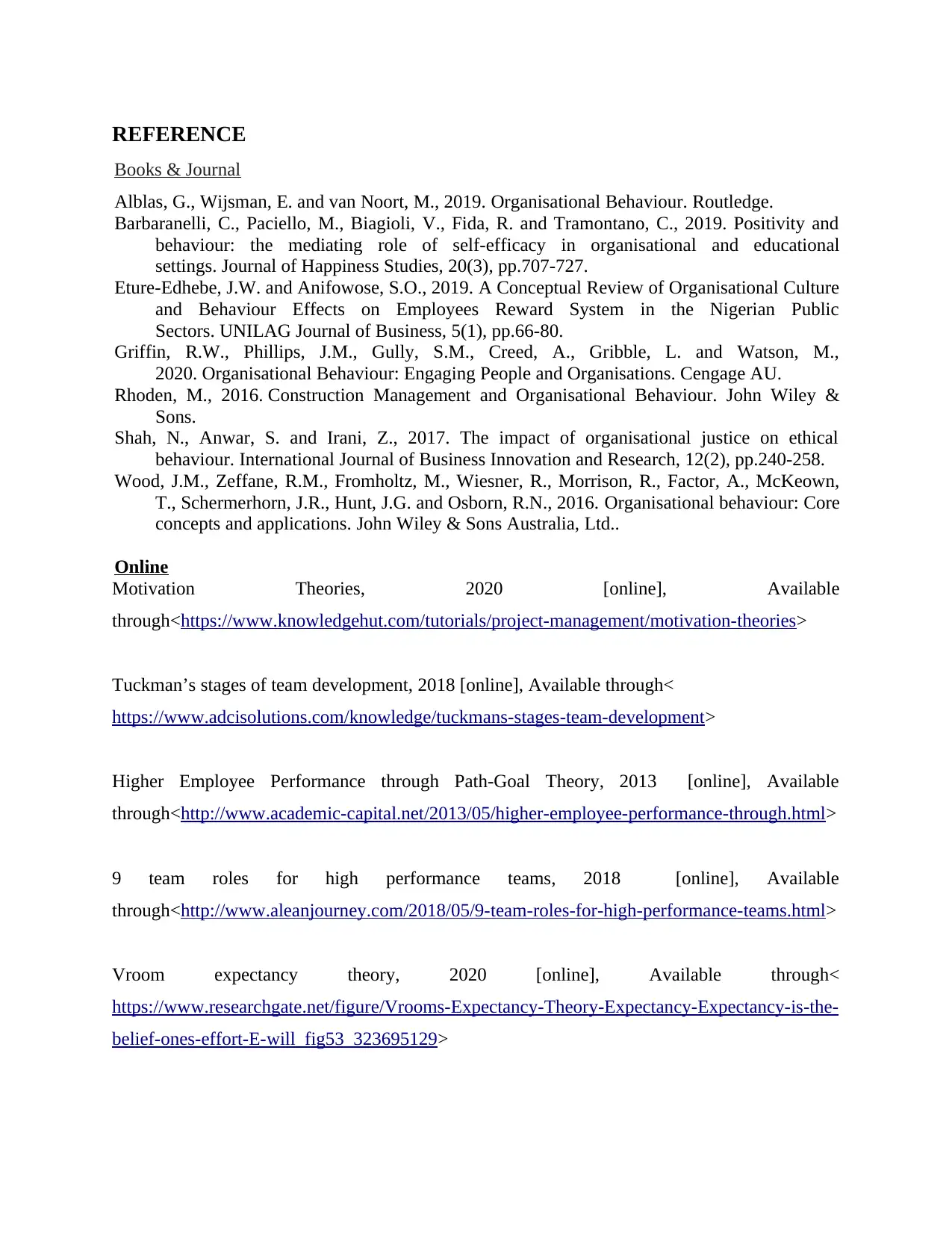
REFERENCE
Books & Journal
Alblas, G., Wijsman, E. and van Noort, M., 2019. Organisational Behaviour. Routledge.
Barbaranelli, C., Paciello, M., Biagioli, V., Fida, R. and Tramontano, C., 2019. Positivity and
behaviour: the mediating role of self-efficacy in organisational and educational
settings. Journal of Happiness Studies, 20(3), pp.707-727.
Eture-Edhebe, J.W. and Anifowose, S.O., 2019. A Conceptual Review of Organisational Culture
and Behaviour Effects on Employees Reward System in the Nigerian Public
Sectors. UNILAG Journal of Business, 5(1), pp.66-80.
Griffin, R.W., Phillips, J.M., Gully, S.M., Creed, A., Gribble, L. and Watson, M.,
2020. Organisational Behaviour: Engaging People and Organisations. Cengage AU.
Rhoden, M., 2016. Construction Management and Organisational Behaviour. John Wiley &
Sons.
Shah, N., Anwar, S. and Irani, Z., 2017. The impact of organisational justice on ethical
behaviour. International Journal of Business Innovation and Research, 12(2), pp.240-258.
Wood, J.M., Zeffane, R.M., Fromholtz, M., Wiesner, R., Morrison, R., Factor, A., McKeown,
T., Schermerhorn, J.R., Hunt, J.G. and Osborn, R.N., 2016. Organisational behaviour: Core
concepts and applications. John Wiley & Sons Australia, Ltd..
Online
Motivation Theories, 2020 [online], Available
through<https://www.knowledgehut.com/tutorials/project-management/motivation-theories>
Tuckman’s stages of team development, 2018 [online], Available through<
https://www.adcisolutions.com/knowledge/tuckmans-stages-team-development>
Higher Employee Performance through Path-Goal Theory, 2013 [online], Available
through<http://www.academic-capital.net/2013/05/higher-employee-performance-through.html>
9 team roles for high performance teams, 2018 [online], Available
through<http://www.aleanjourney.com/2018/05/9-team-roles-for-high-performance-teams.html>
Vroom expectancy theory, 2020 [online], Available through<
https://www.researchgate.net/figure/Vrooms-Expectancy-Theory-Expectancy-Expectancy-is-the-
belief-ones-effort-E-will_fig53_323695129>
Books & Journal
Alblas, G., Wijsman, E. and van Noort, M., 2019. Organisational Behaviour. Routledge.
Barbaranelli, C., Paciello, M., Biagioli, V., Fida, R. and Tramontano, C., 2019. Positivity and
behaviour: the mediating role of self-efficacy in organisational and educational
settings. Journal of Happiness Studies, 20(3), pp.707-727.
Eture-Edhebe, J.W. and Anifowose, S.O., 2019. A Conceptual Review of Organisational Culture
and Behaviour Effects on Employees Reward System in the Nigerian Public
Sectors. UNILAG Journal of Business, 5(1), pp.66-80.
Griffin, R.W., Phillips, J.M., Gully, S.M., Creed, A., Gribble, L. and Watson, M.,
2020. Organisational Behaviour: Engaging People and Organisations. Cengage AU.
Rhoden, M., 2016. Construction Management and Organisational Behaviour. John Wiley &
Sons.
Shah, N., Anwar, S. and Irani, Z., 2017. The impact of organisational justice on ethical
behaviour. International Journal of Business Innovation and Research, 12(2), pp.240-258.
Wood, J.M., Zeffane, R.M., Fromholtz, M., Wiesner, R., Morrison, R., Factor, A., McKeown,
T., Schermerhorn, J.R., Hunt, J.G. and Osborn, R.N., 2016. Organisational behaviour: Core
concepts and applications. John Wiley & Sons Australia, Ltd..
Online
Motivation Theories, 2020 [online], Available
through<https://www.knowledgehut.com/tutorials/project-management/motivation-theories>
Tuckman’s stages of team development, 2018 [online], Available through<
https://www.adcisolutions.com/knowledge/tuckmans-stages-team-development>
Higher Employee Performance through Path-Goal Theory, 2013 [online], Available
through<http://www.academic-capital.net/2013/05/higher-employee-performance-through.html>
9 team roles for high performance teams, 2018 [online], Available
through<http://www.aleanjourney.com/2018/05/9-team-roles-for-high-performance-teams.html>
Vroom expectancy theory, 2020 [online], Available through<
https://www.researchgate.net/figure/Vrooms-Expectancy-Theory-Expectancy-Expectancy-is-the-
belief-ones-effort-E-will_fig53_323695129>
Secure Best Marks with AI Grader
Need help grading? Try our AI Grader for instant feedback on your assignments.
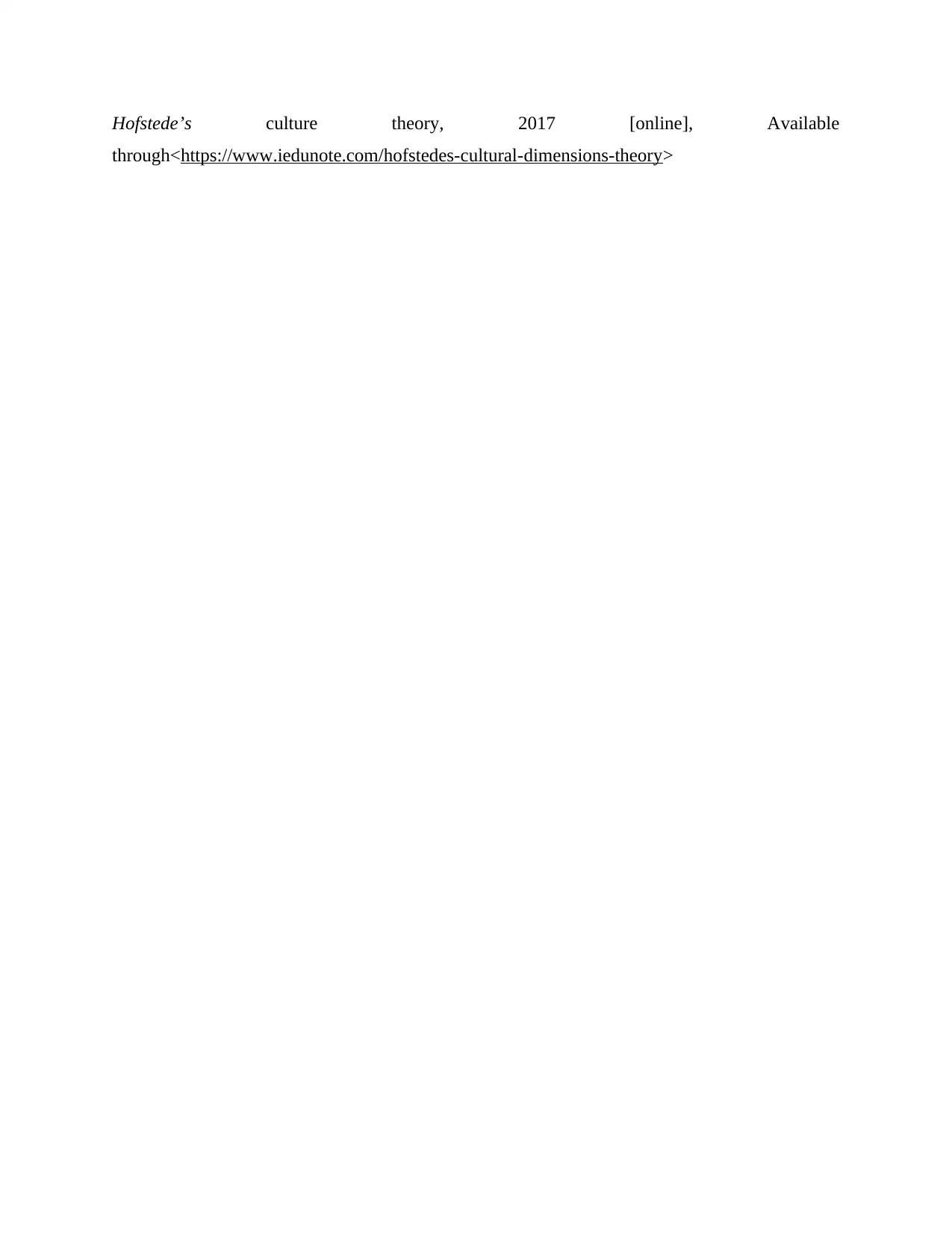
Hofstede’s culture theory, 2017 [online], Available
through<https://www.iedunote.com/hofstedes-cultural-dimensions-theory>
through<https://www.iedunote.com/hofstedes-cultural-dimensions-theory>

1 out of 18
Related Documents
Your All-in-One AI-Powered Toolkit for Academic Success.
+13062052269
info@desklib.com
Available 24*7 on WhatsApp / Email
![[object Object]](/_next/static/media/star-bottom.7253800d.svg)
Unlock your academic potential
© 2024 | Zucol Services PVT LTD | All rights reserved.




